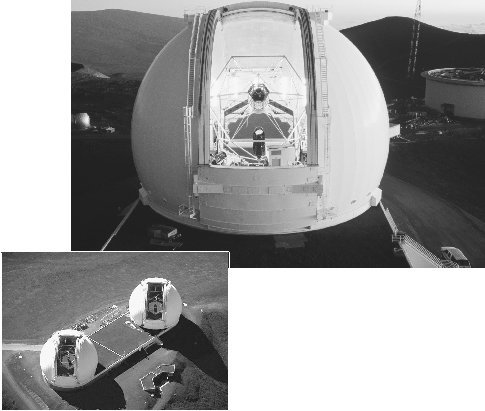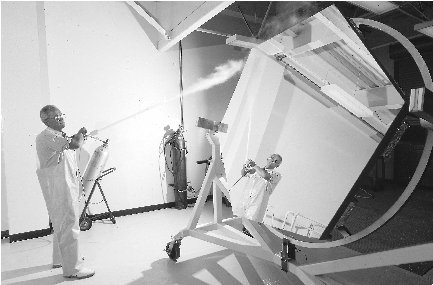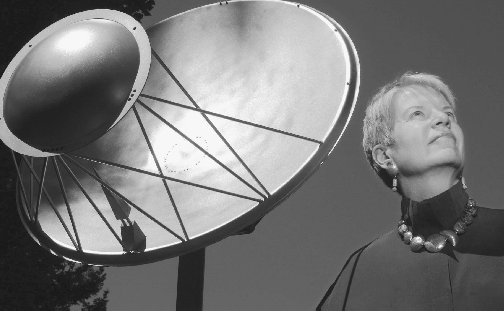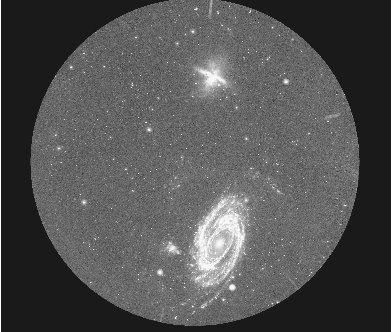Chapter 6
Peering into the Future
The astonishing success of the Hubble, Chandra, and HETE telescopes whetted astronomers' appetites for resolving more complicated mysteries about the universe. Unraveling these mysteries will require further discoveries about the universe, which, in turn, will require more efficient, improved, and exotic telescope designs.
Just as Galileo turned Old Discoverer to the Milky Way to discover that the blur of lights was actually millions of individual stars, twenty-first-century astronomers must continue to experiment to improve upon optics and telescope designs if further discoveries are expected. Fortunately for the future of science, newer, more unusual, and improved telescopes capable of discoveries that eclipse those of a decade or two ago are already either in orbit or scattered about the earth's surface. Indeed, telescopes are no longer just for discovering more galaxies, black holes, and supernovas; they are also being designed to conduct exotic experiments, to search for alien intelligent life, and possibly to locate a planet for future colonization.
Telescopes as Time Machines
From a remote outpost on the summit of Hawaii's dormant Mauna Kea volcano, astronomers at the W.M. Keck Observatory probe the deepest regions of the universe

Working in unison, each lens operates with nanometer precision to look at faint objects an estimated 13 billion light-years away. Such faint galaxies are being viewed at a time only 800 million years after the big bang, when the universe was barely 6 percent of its current age. Dr. Frederic Chaffee, director of the Keck Observatory, makes the analogy that "telescopes are virtual time machines, allowing our astronomers to look back to the early history of the cosmos, and these marvelous observations are of the earliest time yet." 30
At the heart of each Keck telescope is a revolutionary primary mirror, each of which captures different wavelengths of light, and combines them, using computers, into one image. Describing this unique design Keck astronomers say, "The two telescopes give astronomers the ability to resolve cosmic objects as though they were using a single mirror 85 meters [3,349 inches] in diameter." 31 The mirrors are synchronized to an accuracy of 30 nanometers, and that precision allows scientists to view the faintest stars in the most distant galaxies. Many of these observations are part of NASA's Origins program dedicated to the search for the earliest evidence relating to the birth of the universe. According to astronomer Sandra Faber, "Great telescopes like the Kecks allow us to explore the River of Time back toward its source. The Kecks will allow us, like no other telescope in history, to view the evolving universe that gave us birth." 32
The secret to the Kecks' ability to see deep into space is the wizardry of their mirror design. The twin mirrors are enormous, yet neither is a single mirror. Each is composed of thirty-six individual hexagonal segments that move in concert as a single piece of reflective glass. Each

Chilling the interiors of the insulated observatory domes during the day controls temperature variations that could induce deformation of the telescope's steel and mirrors. This is a big task; each dome contains more than 700,000 cubic feet of volume. Giant air conditioners run constantly during the day, keeping dome temperatures at or below freezing. At night when the dome is opened, exposing the telescope to the frigid night air, the telescope already is at the ambient outdoor temperature.
Are We Alone?
The revolutionary design of adjustable mirror segments was not the only radical mirror design for twenty-first-century astronomers. On a mountaintop in Arizona, the world's largest pair of binoculars scans the night sky. What these gargantuan binoculars are looking for might be more astonishing than what they look like.
In the mid-1990s, it seemed nothing new could be imagined for telescopes. There were already a proliferation of them in space and on land, and multiple telescopes connected by interferometric electronics seemed the height of innovation. Yet, optical engineers suggested still another new idea that neither Galileo nor Edwin Hubble could have imagined. They suggested, and later built, a binocular telescope on Mt. Graham, Arizona, called the Large Binocular Telescope (LBT).
The LBT looks much like massive binoculars. It consists of two 8.4-meter (331-inch) primary mirrors that are mounted in a single structure separated by just 47 feet. The mirrors can be used independently or as binoculars by sending the light of both mirrors to a single camera between the telescopes. At a remote 10,700-foot elevation, atmospheric conditions are excellent for capturing visual light. Used in its dual capacity, the LBT will be able to create extraordinarily sharp pictures of distant planets ten times smaller than those photographed by the HST.
The Search for a New Home
Lately, many people have begun wrestling with the question of whether humans should begin a search for a new home far from the earth's polluted environment. Alan Dressler is one of several astronomers who have discussed such a search, and the following statement can be found on the Web site Origins (www.origins.jpl.nasa.gov):
It will require ambitious telescopes to detail the conditions of such a world with evidence for seas and continents, and seasonal variations. We cannot yet know whether the worlds we seek are common or exceedingly rare, so our journey may eventually involve great flotillas of large telescopes that can extend the search to thousands or tens of thousands of stars. If the will and spirit hold, physics says it can be done.
Will we humans leave our home in the Solar System and begin to migrate over the Milky Way as we once spread over the earth? From our view at the beginning of this new century it seems both inevitable and impossible. But, if we find, in the orbit of a neighboring star, a planet resembling earth, one where human beings might conceivably live, the quest could become an obsession. Perhaps our descendants will praise us for our initiative, perhaps they will curse the relentless curiosity that propels humans into greater accomplishments and greater peril. We go on.
The astronomers have many goals for this telescope, one of which is very different from all others and sounds more like science fiction than science. It is to locate planets that revolve around a star, just as Earth revolves around the sun. Such findings, astronomers believe, may reveal planetary systems suitable for supporting life. In fact, locating such a planet may suggest that other beings could exist in the universe. It may also contribute to the future colonization of other planets as humans migrate into space.
Perhaps the biggest problem faced by LBT astronomers intent on detecting planets orbiting a star is that the parent star is significantly brighter than the planet and, as seen by telescopes, the planet is extremely faint by comparison. This problem makes it imperative to eliminate the glare from the star to study any orbiting planets. The revolutionary technique developed to accomplish this, called nulling interferometry, allows the LBT to filter out the starlight to provide high resolution images of the planets.
Determining whether humans are alone in the universe might be determined by the LBT as it scans the sky for habitable planets, or it might be determined by waiting for aliens on a foreign planet to locate us. Some astronomers, who believe alien life might be more technilogically advanced than our own, have built telescopes in anticipation of their contacting us.
The Search for Extraterrestrial Intelligence
In 1984, a group of astronomers associated with the University of California's Berkeley campus began using telescope technology in an unorthodox way. They founded an astronomy institute called the Search for Extraterrestrial Intelligence (SETI), whose purpose is to search for and hopefully detect electromagnetic signals beamed throughout the universe from intelligent beings beyond the solar system.
SETI scientists believe that life on Earth suggests that given a suitable environment and sufficient time, life could have developed on other planets. They further expect that since there are an estimated 100 billion stars in the Milky Way galaxy, and that billions of galaxies exist in the universe, there ought to be many planets like Earth where intelligent aliens thrive. Whether intelligent technological civilizations exist is only speculation, yet if they exist, their attempts to contact others may be humankind's only hope for discovering them. To detect possible communications from space, SETI has deployed several telescopes, each detecting and recording different electromagnetic wavelengths.
What kind of signals are these scientists likely to receive? According to SETI astronomer Ron Hipschman, "There are really two possibilities. Either the other civilizations are intentionally sending out a signal that is expressly meant to get our attention, or, like us, they just happen to be doing their own business and some of their signals are 'leaking out.'" 33 As an example, Hipschman points out that over the past fifty years or so, all broadcast television shows have been radiating out from Earth at the speed of light; the earliest broadcasts have already traveled fifty light-years, roughly 300 trillion miles, from Earth. Although not yet very far compared to the billions of light-years between galaxies, at some point in time they may be detected by intelligent beings who may wish to signal back. What will an alien signal be like? Hipschman admits no one knows:
We can scarcely imagine their thought processes, or their reasons and methods for communicating with us. All we can do is make some educated guesses based on our own knowledge and technology. And even if we are wrong about the aliens' reasoning, we can still hope that they will try to tailor their signal to our own naïve expectations. 34
One assumption made by SETI astronomers is that any signal from space will be initially weak, gain in strength, and then fade away, all in the span of twelve seconds. This is because it takes twelve seconds for the Arecibo radio telescope's beam to scan any given point in the sky. During that time span an alien signal will initially be at the edge of the reception beam and therefore will be weak. It will become stronger and ultimately peak when the beam is aimed directly at the signal's source and finally it will fade away as Arecibo moves on to search other points in the sky.
Has SETI received anything approximating a signal from space? Yes, say directors, but just once. On August

GALEX: Mapping the Universe
On April 28, 2003, a new satellite telescope named the Galaxy Evolution Explorer (GALEX) was launched into space 428 miles above the earth's surface to answer two new fundamental questions about the universe: How do stars form, and are today's galaxies different from galaxies during the early universe? Anne Kinney, director of astronomy and physics in NASA's Office of Space Science, commented, "The Galaxy Evolution Explorer is crucial to understanding how galaxies, the basic structures of our universe, form and function." 35
Now halfway through its twenty-nine-month mission, GALEX has studied the nature and history of stars and galaxies and has begun to provide the first all-encompassing map of the universe. Dr. Christopher Martin, the project's principal investigator and an astrophysicist at Caltech, added, "This mission will provide the first comprehensive map of a universe of galaxies under construction and bring us closer to understanding how they and our own Milky Way were built." 36 Equipped with a technologically advanced ultraviolet telescope, to detect wavelengths slightly shorter than visible light, the spacecraft has been able to concentrate on young galaxies that actively create stars. After just one year of study, GALEX has witnessed the birth of stars. What appears to occur is that thin clouds of hydrogen, helium, and dustlike interstellar particles act as the raw materials of future stars. As clouds of interstellar particles attract other particles, they gradually increase in size. Eventually, gravity causes the cloud to collapse, causing intense heat. When the temperature reaches about 10 million degrees, a nuclear reaction begins and the star is born. This period of evolution, known as the contraction phase, can take as much as 500 million years for a star the size of the sun.
Scientists hope GALEX will provide an understanding how the chemical elements that make up the Milky Way were formed. Thus far, after only one year of studying galaxies, GALEX has confirmed one existing theory about star formation and contributed new findings that will increase current understandings about the birth of stars. Dr. Martin revealed two of GALEX's most important discoveries:
First, we have found evidence to support an existing theory that older galaxies—those formed during the first half of the life of the universe—produced stars more prodigiously than galaxies
formed during the second half. Second, and unexpectedly, GALEX has located a relatively small number of fairly new galaxies, just a few hundred million years old, that for some inexplicable reason are forming stars at a much higher rate than other galaxies the same age. At this time, we do not know why. 37 GALEX, a satellite telescope, provided this image of two distant galaxies in 2003. GALEX is providing astronomers with a comprehensive map of the universe.
GALEX, a satellite telescope, provided this image of two distant galaxies in 2003. GALEX is providing astronomers with a comprehensive map of the universe.
By the time the GALEX mission ends, Dr. Martin and his staff hope to understand why star formation peaked 7 billion years ago yet explain why a very few newer galaxies continue to produce stars at unusually high rates.
Testing Albert Einstein's Theory
Not all telescopes, regardless of their unique designs, are seeking to answer direct questions about the origin or fate of the universe. Some that are scanning deep space are doing so to find evidence that will confirm or disprove theories about the universe. One such telescope exists to test one of Albert Einstein's most famous theories.
In 1916, in what has been called one of the most brilliant observations of any scientist, physicist Albert Einstein formulated his general theory of relativity, which stands as one of the cornerstones of modern physics. Einstein weaved together space, time, and gravitation, and predicted the existence of such peculiar phenomena as black holes, the expanding universe, and the slowing, stretching, and curving of light as it nears gravitational fields.
The scientific community reveres Einstein as one of the most brilliant physicists since Isaac Newton, yet his general theory of relativity remains one of the least tested of scientific theories. At the beginning of 2004, a team of physicists and astronomers intend to do just that with the assistance of a telescope on the Gravity Probe-B (GP-B) spacecraft.
The purpose of the GP-B telescope, which is unlike any other satellite telescope, is to test two predictions of Einstein's general theory of relativity. It is measuring how space and time are distorted by the presence of the earth's gravitational field and how the earth's rotation spins space and time around with it. On board GP-B are two critical instruments necessary to test these two complicated predictions—a telescope and four gyroscopes. Rex Geveden, the GP-B program manager, announced, "The Gravity Probe B space vehicle houses two of the most challenging science instruments ever devised that seek to answer some of the most important questions about the structure of our universe." 38
GP-B's telescope is a Cassegrain reflecting telescope with a 5.6-inch mirror made of optically bonded fused quartz. Optical bonding is a method of fusing together quartz parts, without the use of any glue or fasteners, to ensure that the lens does not distort or break when cooled to extremely low temperatures. Unlike most other telescopes, this telescope was not designed to photograph or study fiery objects in deep space; its role was to locate the star HR 8703, named IM Pegasi, known to astronomers as a guide star, and point to it continuously with absolute precision.
The four gyroscopes, perfectly round yet each only the size of a golf ball, spin at ten thousand revolutions per minute. When the experiment began, the telescope established alignment with the guide star and locked on to it without any deviation. The gyroscopes were aligned with the telescope so that initially their spin axes also pointed to the guide star. The gyroscopes were spun, and over the course of a year, while keeping the telescope (and satellite) aligned with the guide star, the gyroscopes' spin axes will be monitored to detect any deflection or drift due to the earth's gravity or spin.
If the predictions based on Einstein's theory are correct, the gyroscopes' spin axes should slowly drift away from their initial guide star alignment—both in the satellite's orbital plane, due to the slowing of time and curving of light, and perpendicular to the orbital plane, due to the earth's spin. Scientific writer Leonard David asserts, "Gravity Probe B is one of the few space missions NASA has conducted with relevance to fundamental physics. If successful, it would assuredly join the ranks of the classical experiments of physics. By the same token, a confirmed result in disagreement with GR [general relativity] would be revolutionary." 39
Following thirty days of calibration, the mission scientists began to gather data on the precise spin-axis orientation of the gyroscopes. The probe has begun sending back data twice a day. In early 2004, with several months to go, indications are that Einstein's predictions were quite accurate, although NASA expects the final analysis of the huge pile of data to take at least another year.
What questions telescopes will be called upon to answer in the next few decades or next century is nearly impossible to know. Many raised over the past century remain elusive and unanswered, while many more will surely be added. Regardless of the number or complexity of telescopes, modern astronomers will continue to indulge their imaginations constructing telescopes that will be just as unbelievable and complicated to present-day telescope builders as the Hubble, Keck, LBT, and GP-B would surely be to Lippershey, Galileo, and Newton. In astronomer Alan Dressler's view:
Astronomy has given us something that will help answer our ancient questions: Where did we come from? Are we alone in the universe? When the answers to these questions are known, our civilizations will evolve new visions of who we are and what our futures might be. Already we have learned enough to appreciate that the universe is enormous and ancient, but life—tiny and transient —is its precious jewel. 40
Comment about this article, ask questions, or add new information about this topic: